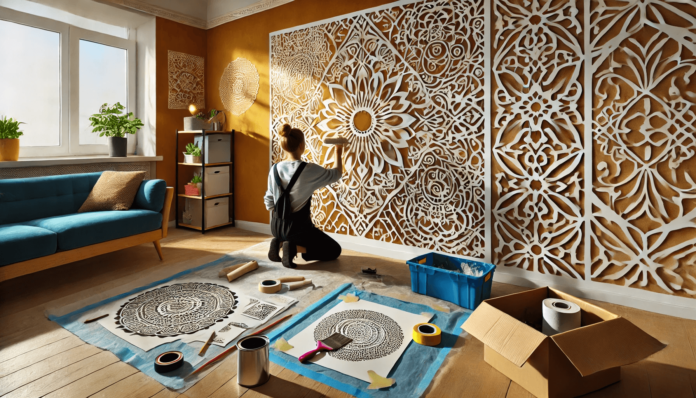Introduction
Using wall stencils is an easy and affordable way to add personality and flair to any room. Whether you’re adding flair to an accent wall or designing a one-of-a-kind border, stenciling offers a creative way to personalize your space with detailed patterns or striking designs. This stencil painting guide will walk you through everything from choosing the right stencils to applying paint for a flawless finish. With a few simple steps, you can transform your walls into a creative masterpiece that reflects your personal style.
How to Use Wall Stencils for a Creative Makeover

Wall stencils offer an easy and affordable way to give your home a personalized touch. Whether you’re looking to add a bold accent wall or subtle decorative details, stenciling can transform any room with unique patterns and designs. To get started, select a stencil that complements your space, secure it in place with painter’s tape, and apply the paint using light, even strokes. Ensure the paint is completely dry before carefully removing the stencil to prevent smudging and achieve crisp, clean lines in your design. With the right technique, you can achieve a professional-looking design that adds character to your walls.
Choosing the Right Stencil for Your Space
The first step in any stenciling project is selecting the right stencil design. When selecting colors and patterns, consider the overall theme and style of your room to ensure your design harmonizes with and elevates the space’s aesthetic. For a modern look, opt for clean lines, neutral tones, and minimalist patterns to create a sleek, cohesive feel. look, geometric patterns or abstract designs work well, while floral or nature-inspired stencils are perfect for a more traditional or bohemian vibe. Stencils come in a wide variety of designs, from simple patterns to complex, layered creations. You can also opt for custom-made stencils for a truly unique touch.
Materials You Will Need
Before you start, gather all the materials necessary for stenciling:
- Stencils: Choose pre-made or create your own.
- Paint: Choose wall paint or craft paint in the colors that best suit your style and vision for the space, allowing for a personalized and vibrant finish.
- Brushes, Rollers, or Sponges: For applying paint to the stencil.
- Painter’s Tape and Level: To secure the stencil and ensure accurate placement.
- Drop Cloths: Use drop cloths or plastic sheeting to safeguard your floors from accidental paint drips and spills, keeping your workspace clean and mess-free.
Prepping the Wall for Stenciling
Proper preparation is key to achieving a professional-looking stencil design. Begin by thoroughly cleaning the walls to eliminate dust, dirt, and grease, ensuring a smooth surface that allows the paint to adhere properly and last longer. If the wall is uneven or textured, consider sanding or patching any rough areas. Apply a base coat of paint in your desired background color, and allow it to dry completely before stenciling.
Positioning the Stencil
Use painter’s tape or adhesive spray to secure the stencil to the wall. Make sure it’s level by measuring and marking key points on the wall. If you’re using a repeating pattern, carefully align the stencil each time to maintain consistency. For single-image stencils, ensure the placement is centered or strategically positioned for the best effect.
Applying the Paint
To avoid paint bleeding under the stencil, use a small amount of paint and apply it lightly. Dab the paint onto the stencil with a brush, roller, or sponge, building up layers slowly for even coverage. If you’re using multiple colors, allow each section to dry before moving on to the next.
Removing the Stencil
Once the paint has dried to the touch, carefully peel off the stencil. Take your time to avoid smudging the design. If any paint has bled, touch up the edges with a small brush.
Finishing Touches
After removing the stencil, inspect your design for any areas that need touch-ups or additional layers. You can add more detail with multiple stencil layers or different colors for a more complex look. Once satisfied, seal the wall with a protective topcoat to keep your design looking fresh.
Common Stenciling Mistakes to Avoid
Be mindful of common stenciling errors like using too much paint or misaligning the stencil. Overloading the brush can lead to paint bleeding under the edges, while improper alignment can create uneven patterns. Be patient and let each coat of paint fully dry before applying the next layer. This guarantees a flawless, uniform finish while avoiding streaks or patchy areas, ensuring your paint job looks professional and polished.
Inspiration: Creative Stencil Ideas
Stencils offer endless creative possibilities, extending far beyond accent walls. They can be used to add artistic touches to furniture, create intricate borders, or even design unique patterns on ceilings and floors, allowing you to personalize every corner of your space. Try stenciling furniture, creating a faux wallpaper look, or adding stenciled designs to smaller spaces like closets, nooks, or entryways. The possibilities are endless!
Conclusion
Stenciling is a versatile and enjoyable way to add personality to any room. By following this step-by-step guide, you’ll be able to create stunning, professional-looking designs with ease. Don’t be afraid to experiment with different stencil patterns and paint colors to truly make your space your own.
FAQs
- Can I use stencils on textured walls?
- Yes, but you may need to use more paint and be extra careful with alignment to avoid smudging.
- What type of paint works best for stenciling?
- Acrylic or latex wall paint works well, but craft paint can also be used for smaller projects.
- How do I fix paint bleeding under the stencil?
- Use a small brush to carefully touch up any areas where the paint has bled.
- How do I clean stencils for reuse?
- Clean the stencil using warm, soapy water, then ensure it is completely dry before storing it to maintain its shape and longevity for future use.
- Can stenciling be done on furniture or other surfaces?
- Yes, stencils can be used on furniture, floors, and even fabric for a custom look.














